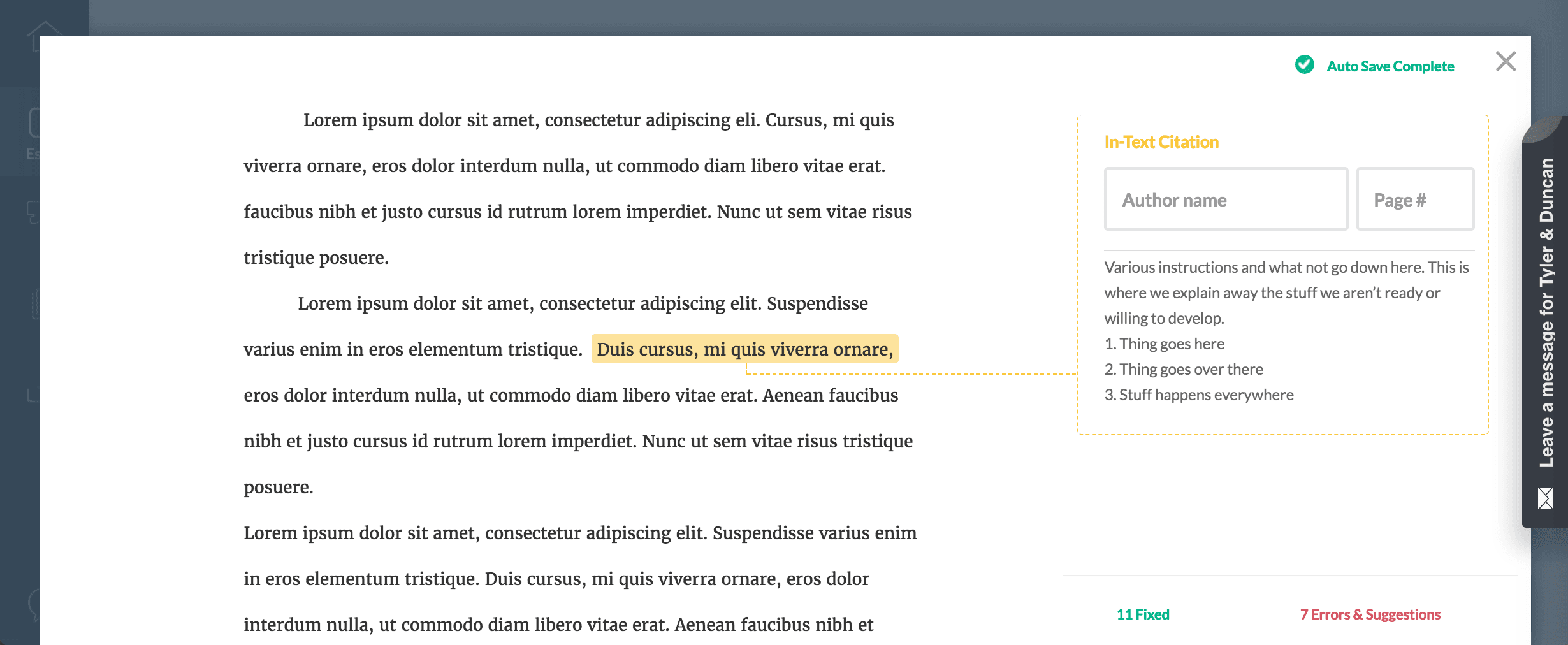In-text citations are required when you use someone else's ideas, theories or research in your paper.
In-text citations are citations within the main body of the text and refer to a direct quote or paraphrase. In-text citations: Correspond to a reference in the main reference list. They contain the first word of the reference, which is usually the author’s surname, and the page, or page-range in which the reference is found. Citation definition is - an official summons to appear (as before a court). How to use citation in a sentence. Synonym Discussion of citation.
Quick Guide
Examples: (choose depending if author and/or date is mentioned in text)
Quotation:
- 'The bones were very fragile' (Cole, 2019, p. 13).
- Cole (2019) found that 'The bones were very fragile' (p. 33).
- In 2019, Cole found that 'The bones were very fragile' (p. 33).
Paraphrase:
- The bones broke easily because they were porous (Cole, 2011).
- Cole (2011) discovered that the bones broke easily.
- In 2011, Cole found that the bones were easily broken (p. 33).
Note: APA style encourages the inclusion of page numbers for paraphrases, but it is not mandatory. Include page or paragraph numbers if it will help reader find the information.
Authors
No authors: Use the title in place of author. Shorten title if needed. Use double quotation marks for title of an article, a chapter, or a web page. Use italics for title of a periodical, a book, a brochure or a report.
- the observations found ('Arctic Voyage,' 2014)
- the book Vitamin Discoveries (2013)
Two authors: Within the text use the word and. If the authors' names are within parentheses use the & symbol.
- Cole and Dough (1998) argued ...
- ...if they were left to their own devices.(Cole & Dough, 1998)
Three or more authors: Include only the last name of the first author followed by 'et al.'
(Wasserstein et al., 2017)
Groups
Spell out the name in full the first time and abbreviate subsequent times only if abbreviation is well known.
- First time: American Psychological Association (2020) explained...
- Second time: APA (2020) proved ...

Quotations

When quoting always provide author, year and specific page citation or paragraph number for nonpaginated material.
If the quotation is less than 40 words incorporate it into the text and enclose the quotation with quotation marks. Cite the source immediately after the close of the quotation marks.
If the authors are named in the text, they do not have to be used in the citation.

In fact, 'a neurosis is characterized by anxiety' (Kristen & Warb, 2012, p. 157).
'A neurosis is characterized by anxiety,' according to Kristen and Warb's (2012, p. 157) longitudinal study.
If the quotation is over 40 words, you must indent the entire quotation and start the quotation on a new line. No quotation marks are required. Cite the quoted source after the final punctuation mark.

Alberta is occasionally divided into two regions, Northern Alberta and Southern Alberta. The majority of Alberta's population is located in large urban cities, mostly located in the South. Alberta is Canada's most populous province of all three Canadian Prairie provinces. Edmonton is the Capital of Alberta. (Hern, 1996, p. 22)
Paraphrasing
APA style encourages the inclusion of page numbers, but it is not mandatory. Include page or paragraph numbers if it will help reader find the information.
- (Reiton, 2003, para. 3)
If the document does not contain page numbers, include paragraph numbers.
- (Reiton, 2003, para. 3).
Citations Meaning
If neither is available omit page and paragraph numbers. Do not count paragraph numbers.
When paraphrasing from multiple sources, include all authors name in parentheses in alphabetical order.
Citations Machine
- (Cole, 2006; Mann & Arthur, 2011; Zigmung, 2000).
Citation Machine
The citation style you choose will largely be dictated by the discipline in which you're writing, and for most assignments your instructor will assign a style to you. However, as you progress through your academic career, you may find more flexibility in choosing a style that works for you. It's always best to check with your instructor and colleagues as to what style is appropriate. If you have flexibility, use the guide below to help you decide.
Citations Apa
| Humanities: English, Art History, Philosophy, Music, Religion, Language, Linguistics, Etc. | Social Sciences, Education, Engineering, etc. | History, or the Humanities | Physical, Natural, or Social Sciences |
Try: MLA MLA style uses parenthetical in-text citations and a 'Works Cited' list at the end of a paper to link sources | Try: APA APA style uses parenthetical in-text citations and a 'References' list at the end of the paper to link sources | Try: Chicago Notes & Bibliography Chicago notes utilizes footnotes and endnotes to link text to sources. | Try: Chicago Author-Date Chicago author-date utilizes parenthetical in-text citations and a references or works cited list at the end, similar to the APA style. |
| The humanities place emphasis on authorship and interpreting primary sources in a historical context. The author's name is the first piece of information preceding title and publication information on the 'Works Cited' list at the end of the work. | These disciplines place emphasis on the date of creation or publication, in an effort to track currency and relevancy. The date is listed immediately following the author's name in the 'References' list. | Typically accompanied by a 'Bibliography' page. | Typically accompanied by a 'References' or 'Works Cited' page. |
| For more information on the MLA style and how to use it, check out the MLA style page. | For more information on the APA style and how to use it, check out the APA style page. | For more information on this style and how to use it, check out the Chicago Notes and Bibliography style page. | For more information on this style and how to use it, check out the Chicago Author-Date style page. |
